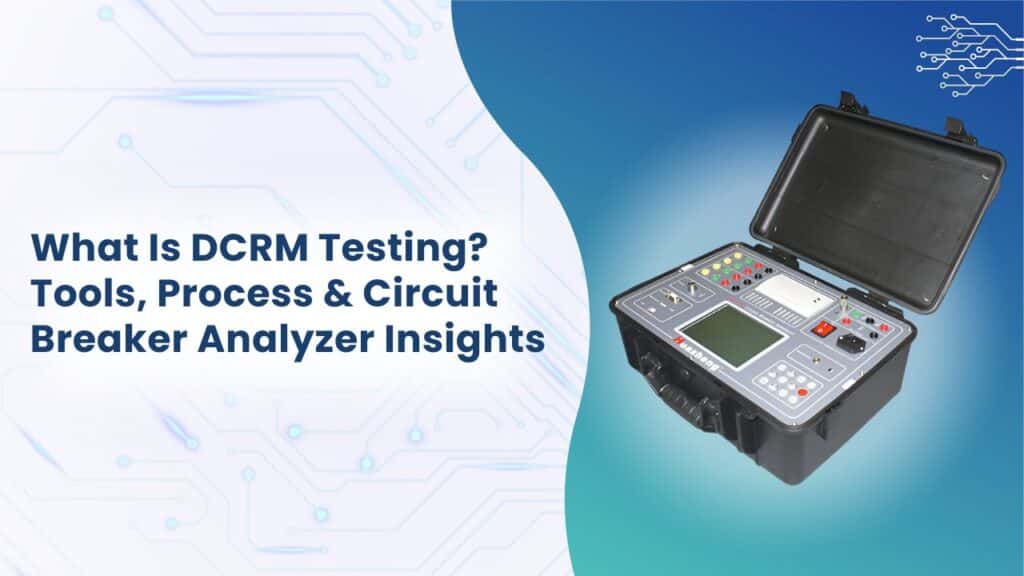- Home
- About Us
- Blog
- Services
- Equipment
- Online Testing
- Offline Testing
- Partial-Discharge
- CPC 100 Multifuncational Switchyard
- Vlf Tan Delta Measurement
- Current Signature Analysis
- Relay Measurement
- CT Measurement
- SFRA Measurement
- Moisture Analysis by PDS & PDC
- Turns-Ratio-Measurement
- Winding Resistance Measurement
- OLTC-DCRM-Measurements
- Frequency Response stray Losses
- Circuit Breaker Analyzer & DCRM Test
- Circuit Breaker Timer
- Contact Resistance Meters
- Particle Count Tester-Pamas
- TRAX Multifunctional switchyard Diagnostic Test
- TESTRANO-600
- Surge Tester-jabbals
- Circuit Breaker Analyzer
- Gallery
- Careers
- Contact Us
What Is DCRM Testing? Tools, Process & Circuit Breaker Analyzer Insights

In electrical power systems, it is very important to keep circuit breakers reliable and safe. With these in place, electrical networks can stop harmful current flows, avoid damage, and keep functioning properly. Testing conducted by specialists proves that circuit breakers fulfill their objectives.
One such advanced diagnostic method is DCRM testing, or Dynamic Contact Resistance Measurement testing. This comprehensive guide, brought to you by Lax Energy Solutions, delves into what it is, the tools involved, the testing process, and the pivotal role of a circuit breaker analyzer in ensuring optimal performance.
Understanding DCRM Testing
Dynamic Contact Resistance Measurement testing helps doctors test the condition of circuit breakers by monitoring their contact resistance as they operate.
Static contact resistance tests the resistance when the breaker is stationary, but this testing measures it as the breaker’s contacts are moving. This way of testing gives a clearer view of how the safety switch will behave in real-life situations, revealing possible problems not seen by static tests.
The main job of this is to discover abnormalities such as damage to the contacts, leaking, misalignment, or inadequate pressure on the contacts. If these issues are spotted early by technicians, it prevents breaker failures, decreases time when the system is not working, and boosts the dependability of the system.
This testing is crucial for ensuring the reliability of high-voltage and medium-voltage safety switches in power plants, substations, and industrial facilities.
Why Does DCRM Testing Matter?
Safety switches are electrical systems’ unsung heroes, protecting both people and property against short circuits and overcurrents. Meanwhile, wear and tear, environmental factors, as well as operational stress, can degrade their performance over time. It is critical for several reasons:
Early Fault Detection: When operating the network, it can spot small changes in contact resistance, which may signal contact erosion or contamination that have not yet led to big issues.
Enhanced Safety: If a safety switch is faulty, it may cause arcing or start a fire. This verifies that breakers function safely, looking after both workers and the company’s assets.
Reduced Downtime: A Continuous Power – Because proactive testing reduces the chance of unexpected failures and critical functions receive uninterrupted power.
Compliance with Standards: Regulatory bodies such as IEEE and IEC require the safety switch to be tested regularly. This is important since it helps ensure compliance and prevents fines.
Cost Savings: By extending breaker lifespan through timely maintenance, It optimizes maintenance budgets and reduces replacement costs.
Tools for DCRM Testing
For effective testing, this requires specialized tools, with the circuit breaker analyzer being the cornerstone of the process. These are the main tools used:
1. Circuit Breaker Analyzer
The circuit breaker analyzer measures different aspects like contact resistance, timing, movement, and the amount of current through the coil during operation. Software for real-time monitoring and reporting is available with modern analyzers, so they are essential for doing it.
2. High-Current Source
This requires injecting a high current (typically 100A or more) through the safety switch contacts to measure resistance accurately. A stable high-current source ensures consistent test results.
3. Data Acquisition Systems
These systems capture and store dynamic resistance data during the breaker’s opening and closing cycles, enabling detailed analysis of contact behavior.
4. Motion Sensors
Motion sensors monitor the breaker’s contact movements, linking resistance data to mechanical behavior for enhanced performance analysis.
5. Software for Analysis
Advanced software processes data from the safety switch analyzer, generating graphs and reports that highlight anomalies and guide maintenance decisions.
The DCRM Testing Process
This testing process is systematic, requiring complete expertise and precision to achieve actionable understanding. Here is a step-by-step overview:
Preparation and Safety: Technicians review the breaker’s specifications, maintenance history, and operating conditions. Safety protocols, such as de-energizing the system and using personal protective equipment, are strictly followed.
Equipment Setup: The circuit breaker analyzer is linked to the high-current source and circuit breaker analyzer. Motion sensors and data acquisition systems are installed to capture dynamic data.
Baseline Measurement: A static contact resistance test is performed to establish a reference point for comparison with dynamic measurements.
Dynamic Testing: The safety switch is operated (opened and closed) while a high current is injected through the contacts. The circuit breaker analyzer records real-time resistance, timing, and motion data.
Data Analysis: The collected data has been analyzed to identify anomalies, such as a high resistance increase or irregular contact motion, that inform potential problems.
Reporting: A detailed report is generated, summarizing findings and recommending actions like contact cleaning, adjustment, or replacement.
Follow-Up: If repairs are made, a follow-up investigation ensures the breaker is restored to optimal condition.
Our team at Lax Energy Solutions follows this rigorous process to deliver a comprehensive this tailored to your specific equipment.
Insights from Circuit Breaker Analyzer Data
The safety switch analyzer provides clear and concise data to evaluate the performance and condition of safety switches. Key metrics include:
- Contact resistance profile: A smooth resistance curve during operation indicates healthy contacts, while spikes suggest wear or arcing.
- Timing analysis: The analyzer measures how quickly the breaker opens and closes, ensuring it meets manufacturer specifications.
- Contact speed: Asymmetrical speed patterns may show mechanical trouble, such as misalignment or insufficient lubrication.
- Actionable Insights: Our detailed reports will enable you to make informed, regular maintenance decisions.
By interpreting these metrics, technicians can diagnose issues with precision and recommend targeted maintenance, ensuring circuit breakers perform reliably.
Challenges in DCRM Testing
Although Dynamic Contact Resistance Measurement testing delivers impressive results, it presents several challenges:
- Complexity: The dynamic nature of checking advanced equipment, as well as skilled technicians, requires accurate interpretation of results.
- Safety Risks: This work requires strict safety measures with high currents as well as energized systems.
- Equipment Downtime: This investigation may require taking the safety switch offline, along with careful scheduling to minimize disruptions.
- Data Interpretation: Complete expertise and experience are required to distinguish normal variations from serious issues.
Partnering with a trusted provider like Lax Energy Solutions can overcome these challenges through expertise, advanced technology, and a commitment to safety.
Why Choose Lax Energy Solutions for DCRM Testing?
When it comes to Dynamic Contact Resistance Measurement checking, Lax Energy Solutions is your go-to partner. Here’s why:
- Expert Technicians: Our certified professionals have broad experience in circuit breaker checking, and they will ensure accurate diagnosis.
- Advanced Equipment: We use state-of-the-art safety switch analyzers as well as software for accurate along good results.
- Customized Solutions: We can customize our investigation services to meet the special requirements of your facility, from substations to industrial plants.
- Safety First: We prioritize safety by adhering to industry standards to protect your manpower and tools.
- Actionable Insights: Our detailed reports will enable you to make informed, regular maintenance decisions.
Visit Lax Energy Solutions to learn how we can increase your circuit breaker reliability via this method.
Best Practices for Circuit Breaker Maintenance
Use these best practices to get the most out of Dynamic Contact Resistance Measurement testing :
- Schedule Regular Testing: Routine testing catches issues early, preventing unexpected failures.
- Maintain Records: Keep detailed logs of test results and maintenance activities to track breaker performance.
- Train Staff: Ensure personnel understand the importance of checking and following safety protocols.
- Work with Experts: A company owner can partner with a reputable provider for accurate and reliable checking.
- Stay Compliant: You need to keep up with emerging industry standards to ensure regulatory compliance.
Conclusion
Dynamic Contact Resistance Measurement testing is critical for ensuring the dependability and safety of circuit breakers in electrical systems. This cutting-edge diagnostic technique measures dynamic contact resistance to reveal hidden issues, prevent failures, and significantly prolong equipment lifespan. The circuit breaker analyser and a reliable partner like Lax Energy Solutions are also essential. You can ensure your breakers perform at their best.
Ready to protect your electrical infrastructure? Contact Lax Energy Solutions today to schedule a DCRM test and learn how we can help you run your operations with confidence.
